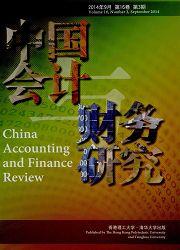On price difference of A+H companies
引用次数: 0
Abstract
PurposeFor Chinese companies that cross-list in Chinese A share and Hong Kong (H share) markets, the H share price has been consistently lower than the A share price by an average of 85% in recent years. This is puzzling because most institutional differences between the two markets have been eliminated since 2007. The purpose of this study is to explain the puzzle of the price difference of A+H companies.Design/methodology/approachUsing all A and H share Chinese firms in the period 2007–2013 and a simultaneous equations approach, this study identifies three new explanations for the recent price difference.FindingsFirst, utilizing a unique earning quality measure that is directly related to non-persistent components of fair value accounting under International Financial Reporting Standards (IFRS), this study finds that the lower the earnings quality, the lower the H share price relative to the A share price, and hence the greater the price difference. Second, the higher the myopic investor ownership in A share firms, the larger the A share price relative to the H share price. Third, the short-selling mechanism introduced to the A share market since 2010 helps reduce the price difference.Originality/valueFirst, this study identifies three new explanations for the puzzle of the AH price difference which remains substantial even after the institutional and accounting standards differences between the two markets were eliminated. Second, we examine the impact of the implementation of fair value accounting under IFRS in an emerging market on the pricing difference of cross-listed shares and reveal that it can induce an unintended negative consequence on the pricing difference of cross-listed shares. Third, this study contributes to the literature on short sales by providing its mitigating role in pricing differences across two different markets. Finally, this study makes improvements in research design, which utilizes a unique measure of earnings quality that is directly related to the implementation of IFRS and a simultaneous equations approach that minimizes endogeneity concern.论A+H公司的价格差异
对于在中国A股和香港(H股)市场交叉上市的中国公司,近年来H股价格一直低于A股价格平均85%。这令人费解,因为自2007年以来,两个市场之间的大多数制度差异已被消除。本研究的目的是解释A+H公司的价格差异之谜。本研究利用2007-2013年期间所有中国A股和H股公司,并采用联立方程方法,确定了近期股价差异的三种新的解释。首先,本研究利用一种独特的盈余质量指标,该指标与国际财务报告准则(IFRS)下公允价值会计的非持续性组成部分直接相关,研究发现,盈余质量越低,H股价格相对于a股价格越低,因此价格差异越大。其次,A股公司的短视投资者持股比例越高,A股相对于H股的股价就越高。第三,2010年以来A股市场引入的卖空机制有助于缩小价差。原创性/价值首先,本研究确定了三种新的解释,即使在消除了两个市场之间的制度和会计准则差异之后,AH价格差异仍然很大。其次,我们考察了新兴市场在国际财务报告准则下实施公允价值会计对交叉上市股票定价差异的影响,并发现它会对交叉上市股票的定价差异产生意想不到的负面影响。第三,本研究通过提供其在两个不同市场的定价差异中的缓解作用,为卖空的文献做出了贡献。最后,本研究对研究设计进行了改进,该研究利用了与国际财务报告准则的实施直接相关的独特的盈余质量测量方法和将内生性问题最小化的联立方程方法。
本文章由计算机程序翻译,如有差异,请以英文原文为准。
求助全文
约1分钟内获得全文
求助全文

 求助内容:
求助内容: 应助结果提醒方式:
应助结果提醒方式:


